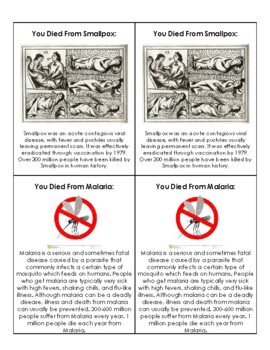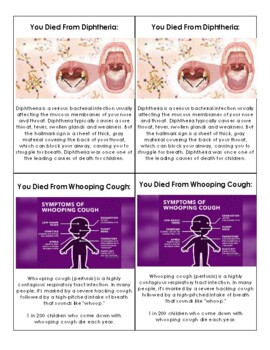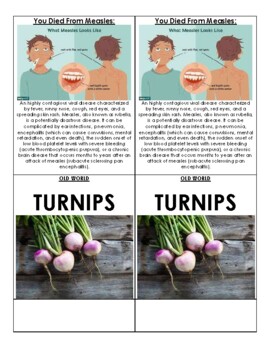Columbian Exchange Trade Simulation
- PDF
What educators are saying
Description
This is one of my personal favorite mini-lessons as well as what I studied in grad school. I always enjoy getting to use my history of epidemiology knowledge in my middle school history classroom and usually, the students do too.
In an effort to show the Columbian Exchange and unintended consequences on the population in the Americas this activity is a quick simulation that will show how the trade of goods spread diseases as an unintended consequence.
Instructions are not included with the flashcard purchase. All instructions are located in the description below or in the linked Google Doc.
Introduction: Trade allows buyers and sellers to make a profit. Buyers are able to purchase items to support themselves and sellers make a profit on their goods. Occasionally negative consequences arise within the trade. You have probably heard of cars being referred to as “lemons” or heard of recalls on certain foods or products. If you knew that something was not going to be a worthwhile investment, you probably would not buy it. Unfortunately, there is rarely a way to tell if something will turn out to be a lemon. That is why voluntary exchange is defined as trading goods and services with other people because both parties expect to benefit from the trade. Today we are going to do a trade simulation based on items found in the Old World and items found in the New World.
Quick Breakdown:
Students are broken up into two groups: Old World or New World. Then they are randomly assigned two to three goods to trade and given those cards.
Small dots on certain cards indicate that students will get ill from trading because of the unintended consequence of disease spread. (Cards do not come with dots. You will choose 10-15 cards to draw a very small dot on the back of the card.) Students will not know they have those cards until the very end.
Once the simulation is over, you can choose how long you want to go, students will flip their cards over to see if they have a small dot.
Students with the card with the dot that no one notices until the end of the game all “die” from malaria, smallpox, etc. except whoever holds quinine as it was an early cure for several diseases.
Step 1- Half of the students will be from the New World and the other half will be from the Old World. Students will receive cards with either Old World or New World foods on them.
Step 2- Half of the Old World cards will have a small red dot on them that is not distinguishable until the end of the activity. Do NOT point this out to the students. Each student will receive 2 cards from their part of the world.
Step 3- Students will be given 3-5 minutes to trade half of their cards within their own groups. They may not trade back their card however they can choose NOT to trade at all.
Step 4- The students will be asked to stop and share what they traded, why they traded or did not trade, and then asked what kinds of goods did they wish they had.
Step 5- Students will be given another 3-5 minute time to trade with the other world. All students must exchange at least one card/trade item with a member of the other world. Before time is up with about 1 minute left of trading time announce that some New World consumers have been exposed to diseases brought over from the Old World that they have no immunity built up for.
Step 6- Students go back to their seats and flip their cards over. Students from the New World that have the small red dot on them will get sick from a European disease, get very ill, and perish. This typically equates to ¾ of the New World students. Pending time, I also have disease cards. If a student contracts a disease, I will give them a card that says one of the following: measles, influenza, smallpox, malaria, diphtheria, typhus, cholera, or whooping cough.
When students go back to their seats, I will ask them to pass up their trade cards and clear their desks and we will talk about the positive and negative impacts of the Columbian Exchange.
POSITIVE:
· Corn- New World to the Old World. Corn is easier to grow in some soils than wheat and rice and became a major source of food for people in Europe, Asia, and Africa.
· Cattle/Oxen/Horses/Pigs/Sheep- Old World to the New World- They became important sources of food and were able to pull heavy loads to help with transportation and farming. Pigs and sheep were used for food and clothing. Horses were used for transportation during hunting.
· Sugar Cane- Old World to the New World- Spain brought sugar to Mexico and it eventually was grown in the Caribbean islands.
· Bananas- Old World to the New World- They grew substantially better in the tropical climates of the New World than they did in SE Asia
· Potatoes- New World to Old World- The climate of Europe was better suited for potatoes and became an important source of nutrition for many countries (Ireland, England, etc.)
NEGATIVE:
· Disease – Old World to New World- Diseases such as smallpox wiped out large numbers of Native Americans because they had no immunity built up to it. Other diseases such as measles, influenza, malaria, etc. also killed a large number of Native Americans.
· Rat infestation- Old World to New World- Rats came to the New World stowed away on ships and infested countries, especially Bermuda. They ate so much food in Bermuda that they almost forced the colonists to leave.
· Exploitation of Workers and Slavery- Old World to New World- Explorers wanted to find gold and silver in the New World and they used any and all means that they could to bring this back to Europe. There was a tremendous loss of life from war, disease killed many Native Americans creating a labor shortage. This caused the Europeans to look elsewhere for laborers, which means they looked to Africa. Between 8 and 10 million slaves were forced to grow and produce tobacco, rice, coffee, and sugar.





